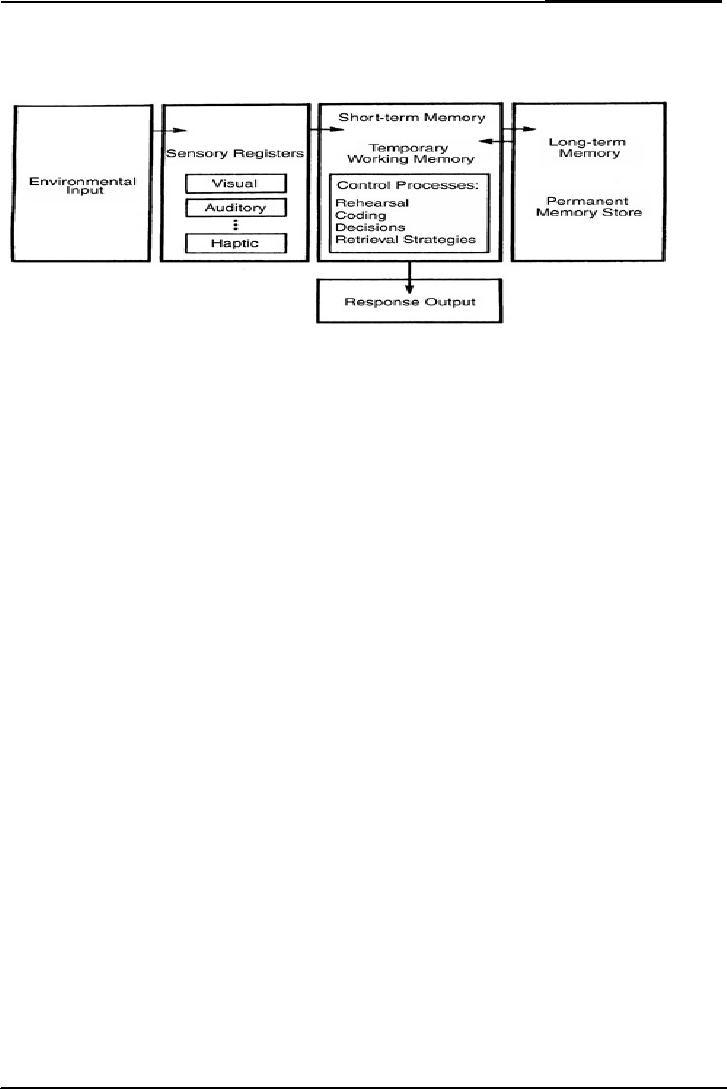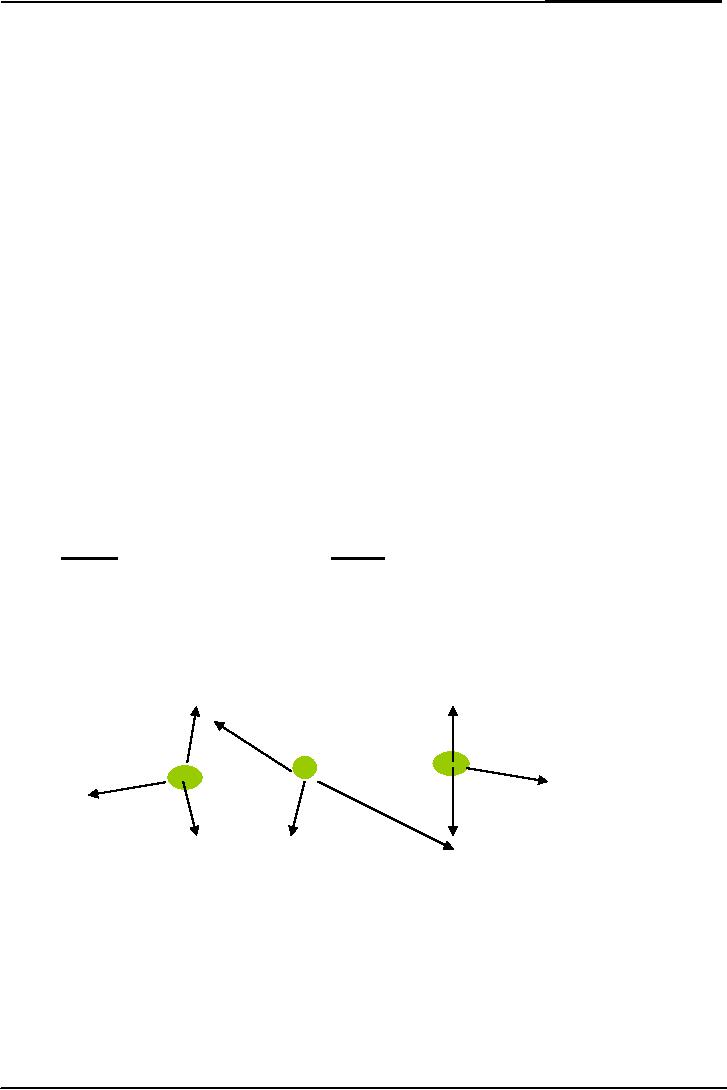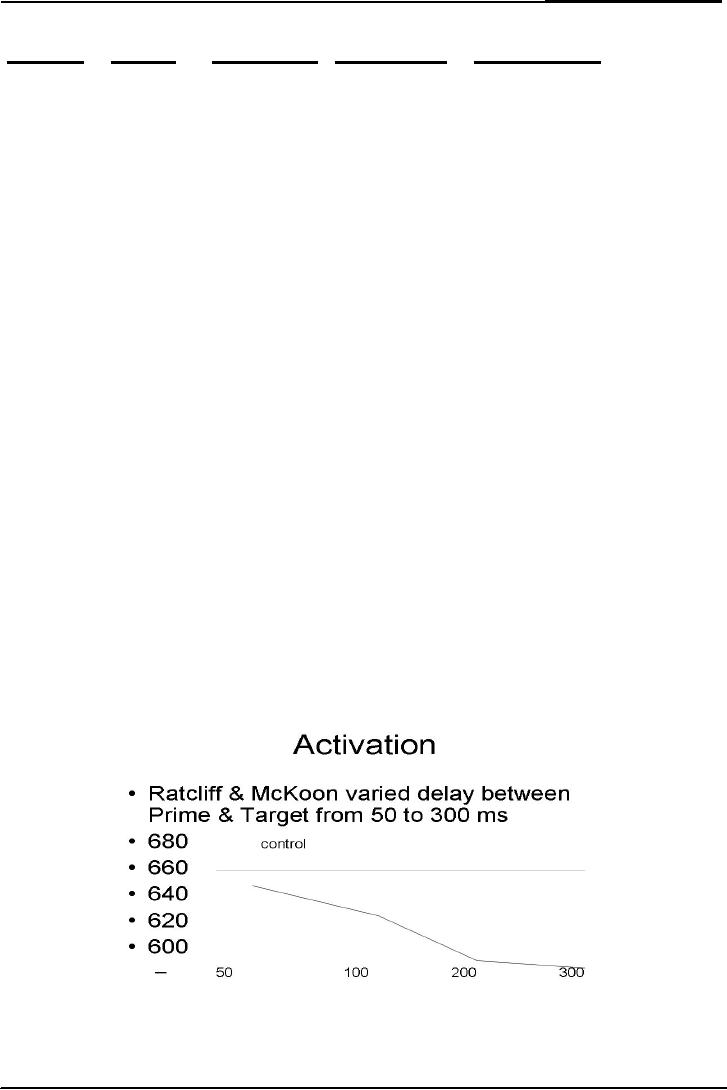 |

Cognitive
Psychology PSY 504
VU
Lesson
29
Memory
Atkinson &
Shiffrin Model
This
model is explaining the
whole process of memory in
short. How the information
goes in
sensory
register then in short term
memory and in long term
memory that is permanent
store
information.
What
do we study?
These
all are the brief
concepts in the study of
long term memory.
Transfer
from STM into LTM
Retrieval
from LTM back into
STM
Recall
versus Recognition
Applications
Studying
and testing
Role
of rote learning
Eyewitness
testimony
Long
Term Memory
Cognitive
psychology is about experiments.
Psychologists do experiment to generate
models,
and
refine models.
Experiment
An
important experiment was
conducted by Anderson in 1976 to
illustrate how speed of
retrieval
varies
with practice. In first
phase they were given
these sentences.
The
Sailor is in the
park.
The
lawyer is in the
church.
Subjects
drilled over and over
again until they know by
heart.
Having
these two sentences the
subjects were tested on
these sentences and asked
whether
each
was among the sentences
they had studied.
The
sailor is in the
park.
The
sailor is in the
church.
Subjects
knew the material enough to
be correct almost all the
time, experimenter was
interested
only
in the speed with which
they made their correct
recognition judgments.
85

Cognitive
Psychology PSY 504
VU
Difference
in study is because of the
delay in presentation.
Results
The
findings were:
Short
Delay
Long
Delay
Less
Study
1.11
1.53
More
Study
1.10
1.38
The
time span of Less Study is
.42 and More Study
.28.
In
less study and short
delay condition subjects
were fastest. And in more
study condition with
short
delay condition the rate
was same. But in long
delay condition and less
study condition the
reaction
time is 1.53.
Delay
made difference. And more
study also made
difference.
The
implication of this study
was weaker memories take
longer time to reactivate. If we
want to
remember
a thing we have to study it
more.
Spread
of Activation
Perlmutter
& Anderson conducted an experiment
that is unpublished, and
cited in book of
Cognitive
psychology.
In
that experiment; subjects
were presented with a
sequence of words and asked
togenerate
associates
that began with specific
letters. They had two
conditions.
In
priming condition there is
pair of letters and words
but these letters and
words are associated.
Like
Dog C for Cat, and
bone- m for meat. In control
condition the words and
letters are
unrelated.
Control
Priming
Dog
- C
Gambler
C
Bone
M
Bone
M
The
reaction time of priming
condition is 1.41 sec. and
the reacton-time of
Control
condition is1.53 sec.
Dog
Bone
Chase
part
of
Cat
Eat
Meat
This
network model is explaining
the difference in both
conditions. Through the word
eat both dog
and
bone is linked. There is
relationship between these
words. The results showed
the priming
condition
is easily recalled. Therefore
the activating the network
structure to answer the
first
associate
should help activate the
structure needed to answer
the second. This
experiment
showed
activation spreads through
long term memory from
active portions to other
portions of the
memory
and this spread takes
time.
Associative
Priming
Mayer
& Schvaneveldt (1971) performed a
classic demonstration of associative
priming. They
had
subjects judge whether or
not pairs of items were
words.
86

Cognitive
Psychology PSY 504
VU
Positive
Pairs Negative Pairs
Unrelated
Related
Non-word
1st
Non-word
2nd
Both
non-words
Nurse
Bread
Plame
Wine
Plame
Butter
Butter
Wine
Plame
Reab
940
855
904
1087
884
If
either item in a pair was a
non-word, subjects were to
respond no. where the
top item was a
non-word,
subjects were faster to
reject the pair than
when only the second
item was a non-word.
Where
the top item was
not a word, subjects did
not have to judge the
second item and so
could
respond
sooner.
Subjects
were fastest in the both
non-words condition. Subjects
were faster in the non-word
first
condition
than in the non-word second
condition. In positive pairs
subjects were much faster
in
related
pairs than in non-related
pairs.
Implications
This
result indicates that
because subjects judged the
first item to be a word,
activation spread
from
that word and primed
information about the
second, associatively related,
item.
Judgment
takes place in the working
memory. The represenatation of
the word has to be active
in
short
term memory.
We
can read related material
faster than non-related
incoherent material where
words might be
presented
randomly.
The
implication is that the
associative spreading of activation
through memory can
facilitate the
rate
at which words are
read.
More
Priming
Ratcliff
& McKoon (1981) report a
rather different priming
demonstration of spreading
activation.
They
had subjects commit to
memory sentences such as The
doctor hated the book.
Subjects
had
to decide whether the noun
"book" was in the studied
sentence. Sometimes a prime
word
such
as "doctor" was presented
just before "book".
Ratcliff
& McKoon varied delay
between Prime & Target
from 50 to 300 ms. All of
these intervals
were
too short for subjects to
develop any conscious
expectations. The decrease in
the reaction
time
reflects the growth in the
level of activation.
87

Cognitive
Psychology PSY 504
VU
Implications
The
implications of the experiment
were
There
is a strong effect of priming in
the Long Term Memory
that is strength of
coding.
Activation
spreads quickly up to 200 ms
after which it slows
down.
For
recognition, information must
first be activated and then
inspected. Activation must
spread to
info
in LTM to be brought into STM.
This takes time (200
ms).
We
see the short term
memory and long term
memory are interacting. STM
has less storage; at
one
time it has 7 things. LTM
keeps information all
things. It has unlimited
capacity for keeping
information.
Another problem in STM is it has
only 20 seconds duration of
storage. But long
term
memory
has permanent
storage.
For
information to be used in a task as a
recognition judgment, it must
first be activated and
then
inspected.
When information is in long-term
memory but not currently in
working memory,
activation
must spread to it, which
takes some amount of time,
as we saw in the McKoon
and
Ratciliff
study. Once activated, the
time to inspect the
information will depend on
its level of
activation,
as was illustrated in the
Sternberg experiment.
88
Table of Contents:
- INTRODUCTION:Historical Background
- THE INFORMATION PROCESSING APPROACH
- COGNITIVE NEUROPSYCHOLOGY:Brains of Dead People, The Neuron
- COGNITIVE NEUROPSYCHOLOGY (CONTINUED):The Eye, The visual pathway
- COGNITIVE PSYCHOLOGY (CONTINUED):Hubel & Wiesel, Sensory Memory
- VISUAL SENSORY MEMORY EXPERIMENTS (CONTINUED):Psychological Time
- ATTENTION:Single-mindedness, In Shadowing Paradigm, Attention and meaning
- ATTENTION (continued):Implications, Treisman’s Model, Norman’s Model
- ATTENTION (continued):Capacity Models, Arousal, Multimode Theory
- ATTENTION:Subsidiary Task, Capacity Theory, Reaction Time & Accuracy, Implications
- RECAP OF LAST LESSONS:AUTOMATICITY, Automatic Processing
- AUTOMATICITY (continued):Experiment, Implications, Task interference
- AUTOMATICITY (continued):Predicting flight performance, Thought suppression
- PATTERN RECOGNITION:Template Matching Models, Human flexibility
- PATTERN RECOGNITION:Implications, Phonemes, Voicing, Place of articulation
- PATTERN RECOGNITION (continued):Adaptation paradigm
- PATTERN RECOGNITION (continued):Gestalt Theory of Perception
- PATTERN RECOGNITION (continued):Queen Elizabeth’s vase, Palmer (1977)
- OBJECT PERCEPTION (continued):Segmentation, Recognition of object
- ATTENTION & PATTERN RECOGNITION:Word Superiority Effect
- PATTERN RECOGNITION (CONTINUED):Neural Networks, Patterns of connections
- PATTERN RECOGNITION (CONTINUED):Effects of Sentence Context
- MEMORY:Short Term Working Memory, Atkinson & Shiffrin Model
- MEMORY:Rate of forgetting, Size of memory set
- Memory:Activation in a network, Magic number 7, Chunking
- Memory:Chunking, Individual differences in chunking
- MEMORY:THE NATURE OF FORGETTING, Release from PI, Central Executive
- Memory:Atkinson & Shiffrin Model, Long Term Memory, Different kinds of LTM
- Memory:Spread of Activation, Associative Priming, Implications, More Priming
- Memory:Interference, The Critical Assumption, Limited capacity
- Memory:Interference, Historical Memories, Recall versus Recognition
- Memory:Are forgotten memories lost forever?
- Memory:Recognition of lost memories, Representation of knowledge
- Memory:Benefits of Categorization, Levels of Categories
- Memory:Prototype, Rosch and Colleagues, Experiments of Stephen Read
- Memory:Schema Theory, A European Solution, Generalization hierarchies
- Memory:Superset Schemas, Part hierarchy, Slots Have More Schemas
- MEMORY:Representation of knowledge (continued), Memory for stories
- Memory:Representation of knowledge, PQ4R Method, Elaboration
- Memory:Study Methods, Analyze Story Structure, Use Multiple Modalities
- Memory:Mental Imagery, More evidence, Kosslyn yet again, Image Comparison
- Mental Imagery:Eidetic Imagery, Eidetic Psychotherapy, Hot and cold imagery
- Language and thought:Productivity & Regularity, Linguistic Intuition
- Cognitive development:Assimilation, Accommodation, Stage Theory
- Cognitive Development:Gender Identity, Learning Mathematics, Sensory Memory